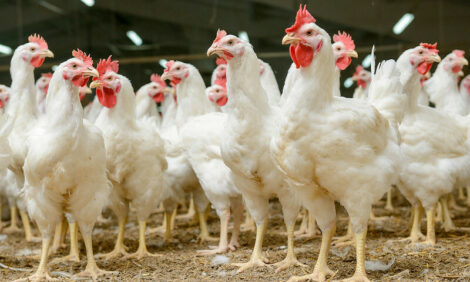



ILT Control Options Present Double-Edged Swords
GLOBAL - Since the 1960s, control of infectious laryngotracheitis (ILT) has been accomplished primarily by vaccination with live, attenuated vaccines that are either of chick-embryo origin (CEO) or tissue-culture origin (TCO).
Both CEO and TCO vaccines are capable of reducing or preventing mortality and drops in egg production. Both can significantly decrease viral shedding after field infection. However, the short-term residual virulence of CEO vaccines can produce severe vaccine reactions and, consequently, economic consequences in broiler production if they are misused during mass vaccination by spray or in the drinking water, reports Poultry Health Today.
Since the early 1970s, ILT vaccination in broilers has been implemented only during outbreaks of the disease. This view was founded on the short life of broilers, which was more uniformly 42 to 56 days at the time, the cost of the vaccines and their application as well as the performance penalty associated with CEO vaccine reactions.
Long-term usage of CEO vaccines can lead to persistence in the field, where it may regain virulence and become another source of outbreaks, also known as vaccinal ILT. High-density poultry production systems serve as a continuous reservoir for these viruses, which are capable of evolving to high levels of virulence. Commercial layer flocks or broiler breeders vaccinated with CEO ILT vaccines can be an additional reservoir of CEO viruses for broilers.
In response to continued epidemics of ILT, a new generation of recombinant vector vaccines was developed. There are two commercially available types: the fowl-pox virus (FPV) vector vaccine that carries the ILT virus glycoprotein B, and the herpesvirus of turkey (HVT) vector vaccines that carry either glycoproteins I and D, or glycoprotein B.
Vector vaccines are considered a much safer alternative for control of ILT since they do not produce a vaccine reaction and cannot regain virulence or actively transmit from bird to bird. In contrast to live, attenuated vaccines, the FPV and HVT ILT vector products can be delivered in ovo, eliminating the need for mass field vaccination.
However, experiments have demonstrated that while the vector ILT vaccines can improve bird performance and ameliorate clinical sings of the disease, they fail to reduce shedding of the challenge virus. These results suggest that in the field, birds without signs of disease can shed high loads of virus, increasing the likelihood of outbreaks. Distribution of ILT cases from an endemic region confirmed that vector vaccines were not able to circumvent the spread of the disease, since 50% of the cases recorded during a 1-year period corresponded to flocks that received vector vaccine products.
Response to ILT outbreaks
Historically, an ILT outbreak prompted poultry companies within a state to reach a consensus about when to start and quit vaccination with CEO ILT vaccines. Depending on the severity of the outbreak, the companies, along with government authorities, delineated a “vaccination zone” or “blanket vaccination” program. In the last decade, the response to an ILT outbreak has transitioned more to individual company action. The reason? Companies are producing a wider range of bird sizes and more ILT vaccines are available for broilers. ILT vaccination can be profitable for the production of heavy birds, but this isn’t necessarily so for producing lighter birds.
Although the level of protection they induce isn’t optimal, companies growing lighter birds tend to rely on the vector ILT vaccines in order to avoid the performance cost of respiratory reactions that occur with CEO vaccination. Due to the high cost of the vector vaccines, however, most companies also cut the dose in half, even though it has been demonstrated in studies that a full dose provides better protection. In some instances, companies switch to a CEO ILT vaccine when outbreaks of the disease cannot be contained solely with the vector ILT vaccines.
Companies that produce a heavy bird tend to use CEO ILT vaccines, or they use a vector ILT vaccine in the hatchery, followed by CEO field vaccination. Some companies growing heavy birds in regions endemic for ILT use the vector vaccines as a preventive measure, especially if they anticipate an ILT field outbreak. In other instances, companies vaccinate with CEO first, then use a vector vaccine to transition away from the CEO vaccines. Finally, some companies growing heavy birds exclusively use CEO ILT vaccines.
The challenge facing the broiler industry is control of ILT in a multiage population of birds with dissimilar levels of disease protection. Birds that are protected poorly or only moderately may have no signs of disease but will shed and spread high loads of virus.
To control the build-up of ILT virus in the house and, consequently, reduce the spread of the ILT virus, several combinations of cleaning and disinfection measures can be implemented between grow-outs. These are not new to the industry, but they are more important than ever for control of ILT. Between grow-outs, no birds are introduced to the house for 14 to 21 days, and during this period, the virus is inactivated by heating the house to 100° F for 72 to 100 hours between flocks. If the house is empty for fewer than 21 days, a thorough wash down of the house and waterlines is also recommended.
Future strategies
What future vaccination strategies and vaccines will make a difference for control of ILT? Under current production parameters, it’s fair to say that broilers in endemic areas are exposed to a high threshold of the ILT virus early in life. It may be advantageous to rethink how ILT vaccination of broilers is approached. Use of the vaccines as a preventive may be preferable to using them in response to an outbreak. The ideal ILT preventive vaccination strategy would require safe, cost-effective vaccines that don’t cause unfavorable reactions and significantly reduce viral shedding. Furthermore, the vaccines would be designed for administration in ovo, at hatch or during the first week of life to induce early immunity.
Several research efforts are underway to evaluate potential new ILT vaccines. One promising candidate is a safe Newcastle disease virus (NDV) vector expressing the glycoproteins B or D of the ILT virus. In contrast to the HVT and FPV vectors, the NDV vector carrying ILT proteins should induce innate and mucosal immune responses that will favor an early onset of immunity against ILT. Other ongoing research involves development of ILT strains with deletion of genes associated with virulence. These gene-deleted strains should cause fewer adverse reactions and, if sufficiently attenuated, can be used as potential live vaccines for use in ovo, as a spray-on at the hatchery or for drinking water administration.
Today we have a much better understanding of the level of safety and protection necessary to properly control ILT. As a result, we’re a step closer to developing more efficient vaccines and to implementing sounder control strategies against this costly disease.
Maricarmen García, MS, PhD
Professor
Poultry Diagnostic and Research Center
University of Georgia









